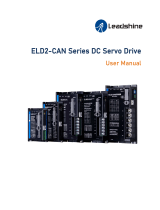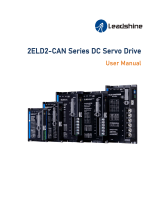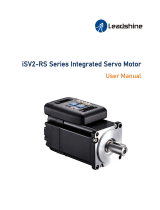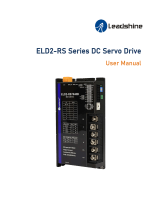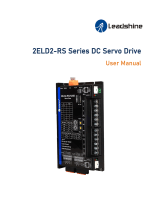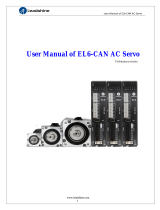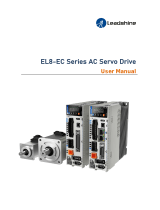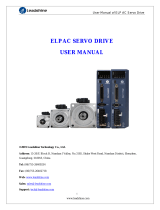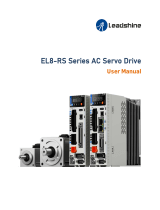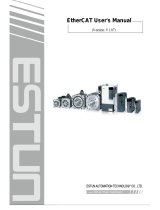Page is loading ...

iSV2-CAN Series Integrated Servo Motor
User Manual

User Manual of iSV2-CAN Integrated Servo
2
Foreword
Thank you for purchasing Leadshine iSV2-CAN series Integrated Servo Motors. This manual
will provide information on the iSV2-CAN series Integrated Servo products regarding product
safety & specifications, installations & wiring, tuning & problem diagnostics.
Please contact us at tech@leadshine.com if you need further technical support.
Incorrect operation may cause unexpected accident, please read this manual carefully before using
product.
We reserve the right to modify equipment and documentation without prior notice.
We won’t undertake any responsibility with any customer’s modification of product and the
warranty of product will be canceled at the same time.
Safety Precautions
Please read the safety instructions carefully before using the products and pay attention to the safety
signs.
Might incur death or serious injury
Might cause injury to operating personals or damage to equipment
Might cause damage to equipment
Hot surface. Do not touch
Protective Earth
Safety instructions
Warning
The design of the product is not to be used in mechanical system which may incur health hazard.
Users should be aware of the product safety precautions during design and installations of the
equipment to prevent any unwanted accident.
Upon receiving Caution
The use of damaged or faulty product(s) is prohibited.
Please refer to item checklist. If the labels don’t match, please do not install.
!
Caution
!
Warning
!
Warning
!
Caution

User Manual of iSV2-CAN Integrated Servo
3
Transportation Caution
Please provide storage and transportation under protected conditions.
Do not stack the products too high up to prevent toppling.
The product should be packaged properly during transportation,
Do not hold the product by the cable, motor shaft or encoder while transporting it.
The product should be protected from external forces and shock.
Installation Caution
Servo drive and Motor:
Do not install around combustibles to prevent fire hazard.
Avoid vibration and impact.
Do not install products that are damaged or incomplete.
Servo drive:
Please install in electrical cabinet with sufficient protection from outside elements.
Reserve sufficient gap as per the installation guide.
Make sure to have good heat sinking.
Avoid dust, corrosive gas, conductive object or fluid and combustibles.
Servo Motor:
Make sure installation is tight to prevent it from loosening.
Prevent fluid from leaking into motor and encoder.
Protect motor from impact to avoid damaging encoder.
Motor shaft should not bear the load beyond the limits as specified.
Wiring Warning
Participate installation personals should have sufficient training in product installation safety.
Please power off and wait for 10 minutes to make sure a full discharge of electricity.
Servo drive and motor must be connected to ground.
Connect the cables only after servo drive motor installed correctly
Make sure the wires are properly managed and insulation layer is not torn to prevent
electrocution. Caution
Wiring must be correctly connected to prevent damage to product(s)
Servo motor U, V, W terminal should be connected correctly and NOT connected directly to an
AC power supply.
Capacitor, inductor or filter shouldn’t be installed between servo motor and servo drive.
Connecting wires or any non-heat resistant components should be put near to heat sink of the
servo drive or motor.
The flyback diode which is connected in parallel to output signal DC relay must not be connected
in reverse.
!
Caution
!
Caution
!
Warning
!
Caution

User Manual of iSV2-CAN Integrated Servo
4
Tuning and running Caution
Make sure the wirings of servo drive and servo motor are installed and fixed properly before
powering on.
On the first time tuning of the product, it is recommended to run unloaded until all the parameter
settings are confirmed to prevent any damage to the product or machine.
Usage Caution
Please install an emergency stop button on machine to stop operation immediately if there is an
accident.
Please make sure machine is stopped before clearing an alarm.
Servo drive must be matched with specified motor.
Frequent restart of the servo system might incur damage to the product.
Servo drive and motor will be hot to touch shortly after power off. Please be careful.
Modification(s) to servo system is prohibited.
Error Handling Warning
Please wait for 5 minutes after powering off for the electricity to be fully discharged before
uninstalling the cables.
Participate maintenance personals should have sufficient training in maintenance and operation
of this product series. Caution
Please handle the error before clearing an alarm.
Keep away from machine after a restart upon alarm. Mechanical axis might suddenly move. Such
hazard should be prevented during the utilization of the product.
Model Selection Caution
Rated torque of the servo motor should be higher than continuous designated torque when fully
loaded.
Load inertia ratio of the motor should be lower or equals to recommended value for specified
models
Servo drive must be matched with specified motor.
!
Caution
!
Caution
!
Warning
!
Caution
!
Caution

User Manual of iSV2-CAN Integrated Servo
5
Warranty Information
Available for
Leadshine overseas warranty only covers Leadshine DC servo products that are obtained through
Leadshine certified sales channel outside of China.
Warranty claim
All Leadshine integrated servo products (Servo drives and motors) overseas enjoy 18-month
warranty period.
Due to unforeseen circumstances in different sales regions around the globe, we recommend
users to seek technical support from directed sales channel as any warranty claim or repair
services may be required.
Please be informed that any maintenance/repair work that is outside of the warranty claim
conditions might incur some charges and to be confirmed before product(s) is being sent in.
The duration required for maintenance work to be done is to be confirmed after initial check-up
but we reserve the right to prolong the repair duration if needed.
Discontinued products within warranty period will be replaced with a product of similar
specifications.
Steps to warranty claim
1. Visit Leadshine global site www.leadshine.com to look for local certified sales channel.
2. Contact designated sales channel to check if any fee might incur. May include repair fee, spare
part cost or shipping cost.
Circumstances where warranty claim is not available
Damage/Loss due to occurrence of natural or man-made disaster such as fire, flood or
earthquake.
Installation or wiring error
If there is any modification done to the product
Warranty label on products is torn or not existing
Not a product bought from Leadshine certified global network of retailers/distributors.
Before warranty claim
Please backup device parameters before any repair work/warranty claim. Leadshine and
Leadshine certified retailers/distributors will not be held responsibilities for any data loss.
If available, please send product back in original packaging or make sure it is well packaged to
prevent any damage to the product during shipping.
Leadshine Technology Co.,Ltd. and its certified sales channel reserved the final right of the
interpretation of the warranty information.

User Manual of iSV2-CAN Integrated Servo
6
TABLE OF CONTENT
CHAPTER 1 INTRODUCTION ................................................................................................................................... 9
1.1 PRODUCT INTRODUCTION................................................................................................................................... 9
1.2 MODEL NUMBER STRUCTURE ................................................................................................................................... 10
1.3 SERVO DRIVE TECHNICAL SPECIFICATION ..................................................................................................................... 11
1.4 INTEGRATED MOTOR PORTS AND CONNECTORS ........................................................................................................... 12
CHAPTER 2 INSTALLATION & WIRING .................................................................................................................. 13
2.1 SERVO DRIVE INSTALLATION ..................................................................................................................................... 13
2.1.1 Servo drive installation environment ......................................................................................................... 13
2.1.2 Integrated Servo Motor Installation .......................................................................................................... 13
2.2 INTEGRATED SERVO MOTOR BASIC INFORMATION ......................................................................................................... 14
2.2.1 Speed-torque curves ................................................................................................................................... 14
2.2.2 Integrated Servo Motor Dimension ............................................................................................................ 16
2.3 ISV2-CAN WIRING DIAGRAM .................................................................................................................................. 17
2.4 INTEGRATED SERVO MOTOR PORTS ........................................................................................................................... 18
2.4.1 CN1 I/O Signal Port .................................................................................................................................... 19
2.4.2 CN3/CN4 Power supply & Regenerative Resistor Port ............................................................................... 20
2.4.3 CN5 CANopen Communication Port ........................................................................................................... 20
2.4.4 CN7 RS232 Tuning Port .............................................................................................................................. 21
2.4.5 ID spin dial RSC ........................................................................................................................................... 21
2.4.6 Baud rate/Terminal resistor switch SW ..................................................................................................... 22
2.5 CABLE SELECTION ................................................................................................................................................... 23
2.5.1 Communication Cable ................................................................................................................................ 23
2.5.2 Tuning Cable .............................................................................................................................................. 23
2.6 REGENERATIVE RESISTOR SELECTION .......................................................................................................................... 24
CHAPTER 3 PARAMETER ...................................................................................................................................... 28
3.1 PARAMETER LIST .................................................................................................................................................... 28
3.1.1 Servo drive parameter ................................................................................................................................ 28
3.1.2 Motion parameter starting with object dictionary 6000 ........................................................................... 34
3.2 PARAMETER FUNCTION ........................................................................................................................................... 36
3.2.1
【
Class 0
】
Basic Settings ........................................................................................................................... 36
3.2.2
【
Class 1
】
Gain Adjustments ..................................................................................................................... 40
3.2.3
【
Class 2
】
Vibration Suppression .............................................................................................................. 48
3.2.4
【
Class 3
】
Velocity/ Torque Control .......................................................................................................... 53
3.2.5
【
Class 4
】
I/O Interface Setting ................................................................................................................. 55
3.2.6
【
Class 5
】
Extension settings .................................................................................................................... 61
3.2.7
【
Class 6
】
Other settings........................................................................................................................... 65
3.3 402 PARAMETERS FUNCTION ................................................................................................................................... 69

User Manual of iSV2-CAN Integrated Servo
7
CHAPTER 4 CONTROL MODE ................................................................................................................................ 81
4.1 PROFILE POSITION MODE ........................................................................................................................................ 81
4.1.1 Pulse ........................................................................................................................................................... 81
4.1.2 Motion settings .......................................................................................................................................... 81
4.1.3 Monitoring settings .................................................................................................................................... 82
4.1.4 Applications example ................................................................................................................................. 82
4.2 PROFILE VELOCITY MODE ......................................................................................................................................... 83
4.2.1 Motion Settings .......................................................................................................................................... 83
4.2.2 Monitoring settings .................................................................................................................................... 83
4.3 PROFILE TORQUE MODE .......................................................................................................................................... 84
4.3.1 Motion Settings .......................................................................................................................................... 84
4.3.2 Monitoring settings .................................................................................................................................... 84
4.4 HOMING MODE ...................................................................................................................................................... 85
4.4.1 Motion Settings .......................................................................................................................................... 85
4.4.2 Monitoring settings .................................................................................................................................... 85
4.4.3 Homing mode ............................................................................................................................................. 86
4.5 EMERGENCY STOP ................................................................................................................................................ 111
4.5.1 Motion Settings ........................................................................................................................................ 111
4.5.2 Monitoring settings .................................................................................................................................. 111
CHAPTER 5 APPLICATIONS ................................................................................................................................. 112
5.1 TRIAL RUN .......................................................................................................................................................... 112
5.2 INERTIA RATIO MEASURING .................................................................................................................................... 113
5.3 NOTCH FILTER (VIBRATION SUPPRESSION) ................................................................................................................ 115
5.4 AUTO GAIN ADJUSTMENT ....................................................................................................................................... 117
5.5 3RD GAIN SWITCHING ............................................................................................................................................. 119
5.6 FRICTION COMPENSATION FUNCTION ........................................................................................................................ 121
5.7 REGENERATIVE RESISTOR SETTINGS .......................................................................................................................... 122
5.8 SAFETY FUNCTIONS ............................................................................................................................................... 123
5.8.1 Max. motor rotational speed limitation ................................................................................................... 123
5.8.2 Max. duration for motor to stop after disabling ...................................................................................... 123
5.8.3 External brake deactivation output signal BRK-OFF ................................................................................ 124
5.8.4 Servo stopping mode ................................................................................................................................ 125
5.8.5 Emergency stop function .......................................................................................................................... 126
5.9 MULTITURN ABSOLUTE ENCODER ............................................................................................................................ 127
5.9.1 Parameter settings ................................................................................................................................... 127
5.9.2 Read absolute position ........................................................................................................................ 128
5.9.3 Absolute Encoder Related Alarm .............................................................................................................. 130
CHAPTER 6 CANOPEN COMMUNICATION .......................................................................................................... 131
6.1 CANOPEN PROTOCOL ........................................................................................................................................... 131
6.2 CANOPEN COMMUNICATION PROTOCOL FOR ISV2 SERIES ............................................................................................ 132
6.4 PREDEFINED CONNECTIONS .................................................................................................................................... 132
6.5 OBJECT DICTIONARY ............................................................................................................................................. 133
6.5.2 Object dictionary structure ...................................................................................................................... 134
6.5.3 Object type ............................................................................................................................................... 134

User Manual of iSV2-CAN Integrated Servo
8
6.5.4 Access attribute ........................................................................................................................................ 134
6.6 NETWORK MANAGEMENT (NMT) ........................................................................................................................... 135
6.6.1 NMT module control ................................................................................................................................ 135
6.6.2 NMT node guarding ................................................................................................................................. 135
6.6.3 NMT Boot-up ............................................................................................................................................ 136
6.6.4 NMT communication status machine ...................................................................................................... 136
6.7 PROCESS DATA OBJECT (PDO) ............................................................................................................................... 137
6.8 SERVICE DATA OBJECT ........................................................................................................................................... 140
6.9 EMERGENCY OBJECT ............................................................................................................................................. 141
CHAPTER 7 WARNING AND ALARM ................................................................................................................... 142
7.1 SERVO DRIVE ALARM OVERVIEW .............................................................................................................................. 142
7.2 ALARM HANDLING ................................................................................................................................................ 147
7.3 CANOPEN COMMUNICATION ALARM ....................................................................................................................... 159
7.4 ALARM CLEARING ................................................................................................................................................. 169
7.4.1 Servo Drive Alarm Clearing ...................................................................................................................... 169
APPENDIX A .............................................................................................................................................................. 170
APPENDIX B .............................................................................................................................................................. 172
APPENDIX C .............................................................................................................................................................. 172
APPENDIX D .............................................................................................................................................................. 173
APPENDIX E .............................................................................................................................................................. 174
CONTACT US ...................................................................................................................................................... 175

User Manual of iSV2-CAN Integrated Servo
9
Chapter 1 Introduction
1.1 Product Introduction
iSV2-CAN Series DC Servo Drive is our latest generation DC servo drive that is based on CANopen DSP402
protocol. It can be easily matched to any controller that supports this protocol. Using the latest signal
processing chip from Texas Instrument, the drive is compact with small volume and good reliability.
In comparison to conventional pulse controlled servo drives, our iSV2-CAN provides advantages as listed
below.
1. Lengthen communication range and lower electromagnetic interference
Due to the reliance of pulse command, pulse controlled servo drives could be easily disrupted by
electromagnetic interferences. CANopen communication protocol provides fault detections limitations
and error handling that makes communication more reliable over long distances.
2. Greater motion control
Trajectory generation can be done within the driver under non-cyclic synchronous mode. Controller only
needs to deliver target position, velocity and acceleration commands to the driver. Drivers can then
achieve greater control by applying feedforward to the commands.
3. Simplify complex wiring work
Using CANopen communication protocols, the connections between master device and slave stations
can be realized using only RS232 cables.
4. Reduce cost by lowering the requirement for more ports
Multiple axes control can be realized without requirement for more ports or pulse module on the
master device/controller. Only a network port is needed to chain the axis controller (drivers) together in
series.

User Manual of iSV2-CAN Integrated Servo
10
1.2 Model Number Structure
iSV2 – CAN 60 40 V48 G
Motor Series
iSV2
iSV2 Series Integrated
Servo Motor
Communication Protocol
RS Modbus RTU/Pul se+D ir ec ti on
CAN CANopen
Motor Brake
HWithout brake
GWith brake
Rated Voltage
24 24VDC
48 48VDC
Motor Flange Size
57 57mm
60 60mm
80 80mm
86 86mm
Rated Power
20 200W
40 400W
75 750W

User Manual of iSV2-CAN Integrated Servo
11
1.3 Servo Drive Technical Specification
iSV2-CAN series CAN6020V24
CAN6020V48
CAN6040V48 CAN8075V48
Rated Current (Arms)
11
6.5
10
19
Peak Current (Arms)
34
20
28
57
Flange size (mm)
60
80
Main power supply
24/48VDC
Drive mode
SVPWM sinusoidal wave drive
Velocity regulation ratio
5000:1
Electronic gear ratio 1~32767/1~32767
Matching encoders ABZ or RS485 encoder(Tamagawa protocol)
Input
4 configurable NPN/PNP 24V Digital Inputs: DI3-DI6
1. Homing Switch (HOME-SWITCH)
2. Positive limit switch (POT)
3. Negative limit switch (NOT)
4. Clear Alarm (A-CLR)
5. Emergency Stop (E-STOP)
Output
2 configurable single-ended NPN/PNP 24V, 8mA digital outputs
1. Alarm (ALARM)
2. Servo ready (SRDY)
3. External brake off (BRK-OFF)
4. Positioning completed (INP1)
5. Reached velocity(AT-SPEED)
6. Torque limit (TLC)
7.Zero speed position (ZSP)
8. Velocity coincidence (V-COIN)
9. Position command (P-CMD)
10.Velocity limit (V-LIMIT)
11. Velocity command (V-CMD)
Alarm
Current circuit error, DC bus overvoltage, DC bus undercurrent, overcurrent,
overcurrent on IPM, motor overload, regenerative resistor overload, encoder
disconnected, encoder initialization error, encoder data error, excessive
position deviation, overspeed, I/O configuration error, EEPROM parameter
saving CRC checksum error, positive/negative position limit valid, forced
alarm input valid
Indicator light
Red & Green LED
Tuning Software
Motion Studio 2
Motion Studio 2
Configure parameters for current, position and velocity loop. Parameter
uploading using .lsr parameter files. Drive and motor data monitoring using
oscilloscope.
Communication Port RS-232,1:1; CAN,0:N(0≤N≤127), CANopen
Load-Inertia
Smaller than 20 times motor inertia
Environmental
requirements
Storage
condition
Avoid direct sunlight. Keep away from heat generating
devices, dust, oil, corrosive liquid/gas and places with
strong vibration or high humidity. Prohibit combustible gas
and conductive material waste.
Temperature -20
℃
~+45
℃
(Please allow air circulation if >45
℃)
Storage
temperature
-20
℃
~+65
℃
Humidity 40—90%RH (Condensation free)
Installation
Vertical and level to ground

User Manual of iSV2-CAN Integrated Servo
12
1.4 Integrated Motor Ports and Connectors
iSV2-CAN Series Integrated Servo Motor (6020/6040/8075)
I/O Port
Indicator LED
(PWR/ALM)
Baud Rate/Terminal
Resistor Switch
RS232 Tuning Port
Main Power Supply
(DC+, DC-)
Regenerative Resistor
(RB+, RB-)
ID Spin Dial (RSC)
CANopen Communication
Port

User Manual of iSV2-CAN Integrated Servo
13
Chapter 2 Installation & Wiring
2.1 Servo Drive Installation
2.1.1 Servo drive installation environment
2.1.2 Integrated Servo Motor Installation
1.
Protection
: iSV2 series integrated servo motor is not waterproof type motors; please prevent
any fluid from splashing or pouring over the motors.
2.
Temperature, humidity:
Environmental temperature should be between -25~40℃ (without
freezing). Temperature raise of the motor is normal under continuous operation please ensure
enough cooling for motors to work at optimum rate. Humidity should be less 90%RH without
condensation.
3.
Vibration:
Please ensure that vibration is not more than 0.5G(4.9m/s2)
4.
Installations
:
(a) Please don’t hammer on the motor or shaft while trying to remove timing pulley to
prevent damage to encoder.
(b) Please use a flexible coupling to prevent excessively large torsion on the shaft.
Temperature
Storage: -20~+65℃ (Condensation free);
Installation: -20~+45℃ ( Please allow air circulation if >45
℃
)
Humidity
Under 90%RH (Condensation free)
Altitude
Up to 1000m above sea level
Atmospheric
pressure
86 ~ 106kPa
Vibration
Less than 0.5G (4.9m/s2) 10-55Hz (non-continuous working)
Atmospheric
No corrosive gas, combustibles, dirt or dust.
IP ratings
IP20

User Manual of iSV2-CAN Integrated Servo
14
2.2 Integrated Servo Motor basic information
2.2.1 Speed-torque curves
200W Motors (iSV2-**20*)
400W Motors (iSV2-**40*)

User Manual of iSV2-CAN Integrated Servo
15
750W Motors (iSV2-**75*)

User Manual of iSV2-CAN Integrated Servo
16
2.2.2 Integrated Servo Motor Dimension
iSV2 Series
LC
LL
H
LA
LZ
TP
RH
W
CAN6020V24H
60
95.7
79 Ø70 Ø5.5
12
16 5
CAN6020V24G
124.7
CAN6020V48H
95.7
CAN6020V48G
124.7
CAN6040V48H
112.7
CAN6040V48G
124.7
CAN8075V48H
80
128.8
100 Ø90 Ø6.6 21.5 6
CAN8075V48G
160.3

User Manual of iSV2-CAN Integrated Servo
17
2.3 iSV2-CAN Wiring Diagram
iSV2-CAN Wiring Diagram
iSV2-CAN series integrated servo motor doesn’t have pulse or analogue input.
Make sure data transferring cables are as short as possible. Keep CN1 cable under 3m and
CN2 cable under 10m. Use shielded double winding cables to cut down on electromagnetic
interference.
If the load for DO is an inductive load such as a relay, please install freewheeling diodes on
both ends of the load in parallel. Please keep in mind that if the diode is connected in reverse, it
might cause damage to the drive.
Use non-fuse breaker (NFB) to cut off power supply to the drive in case of emergency.

User Manual of iSV2-CAN Integrated Servo
18
2.4 Integrated Servo Motor Ports
iSV2-CAN 6020/6040/8075
Connector
Label
CN1
I/O signal port
CN3
Main Power Supply (DC+, DC-)
CN4
Regenerative resistor port (RB+, RB-)
CN5
CANopen Communication port
CN7
RS232 tuning port
SW
Baud rate/Terminal resistor switch
RSC
ID spin dial
LED
Indicator LED (PWR/ALM)
CN1 I/O Port
Indicator LED
(PWR/ALM)
Baud Rate/Term inal
Resistor Switch
CN7 RS232
Tuning Port
CN3 Main Power Supply
(DC+, DC-)
CN4 Regenerative Resistor
(RB+, RB-)
ID Spin Dial (RSC)
CN5 CANopen
Communication
Port
Cooling Vent

User Manual of iSV2-CAN Integrated Servo
19
2.4.1 CN1 I/O Signal Port
Diagram
CN
Pin
Signal
Description
CN1
1
NC
NA
2
NC
3
NC
4
NC
5 COM_IN Common DI
6 DI3 Emergency stop
7 DI4 Homing switch
8 DI5 Positive limit
9 DI6 Negative limit
10 DO1 Alarm output, current output <100mA
11 DO2 Servo ready, current output <100mA
12 COM_OUT Common output
I/O Signal Wiring Diagram
1. DI3-DI6 supports NPN and PNP configuration. Recommended to use an external control signal power
supply of 12-24VDC.
2. DO1-DO2 are single ended outputs with 100mA current output that supports NPN and PNP
configuration. Recommended to use an external power supply of 24VDC. If the load is an inductive load
such as a relay, please install freewheeling diodes on both ends of the load in parallel. If the diode is
connected in reverse, it might cause damage to the driver.
4.7K
COM_IN
DI1
DI1+
DI1-
COM_OUT
DO3
DI
DO (differential)
DO
2 1
12 11

User Manual of iSV2-CAN Integrated Servo
20
CN1 control signal cable selection
To ensure I/O signal to not be affected by electromagnetic interference, a shielded cable is
recommended for this application.
Cables for different analogue signals should be using isolated shielded cable while cables for digital
signals should be shielded twisted pair cable. Cables for CN1 connectors should be 24-28AWG in
diameter.
2.4.2 CN3/CN4 Power supply & Regenerative Resistor Port
2.4.3 CN5 CANopen Communication Port
Port
Diagram
Pin
Signal
Label
CN5
1 CANH CANopen H terminal
3 CANL CANopen L terminal
5 GND Power supply ground
Others NC 10 pins are not
applicable
Port
Pin
Signal
Description
CN3
1
DC+
DC Power Supply positive and negative terminals
2
DC-
CN4
3
RB+
Regenerative resistor positive and negative terminals
4
RB -
Foil shield
CN3
CN4
1
4
/
